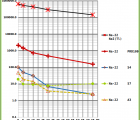
Introduction: Some release of radionuclides into the environment can be expected from the growing number of nuclear plants, either in or out of service. The citizen and the big organization could be both interested in simple and innovative methods for checking the radiological safety of their environment and of commodities, starting from foods.
Methods: In this work three methods to detect radioactivity are briefly compared focusing on the most recent, which converts a smartphone into a radiation counter.
Results: The results of a simple sensitivity test are presented showing the measure of the activity of reference sources put at different distances from each sensor.
Discussion: The three methods are discussed in terms of availability, technology, sensitivity, resolution and usefulness. The reported results can be usefully transferred into a radiological emergency scenario and they also offer some interesting implication for our current everyday life, but show that the hardware of the tested smart-phone can detect only high levels of radioactivity. However the technology could be interesting to build a working detection and measurement chain which could start from a diffused and networked first screening before the final high resolution analysis.
